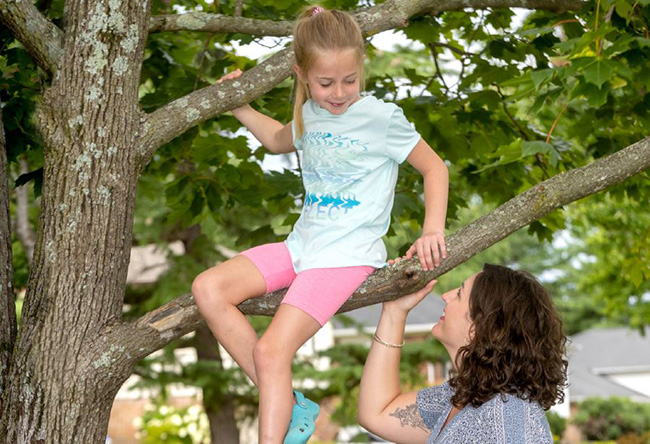
Like many 6-year-olds, Stella Jordan loves to climb—monkey bars, trees, gymnastics equipment, you name it. Unfortunately, that’s how she ended up with a complex fracture of her forearm and a dislocated elbow, known as a Monteggia injury.
“As I was jumping off the equipment at recess, my foot got stuck. I fell and slammed into the ground. It was really scary,” explains Stella.
It was scary for Stella’s mom, Amy, too. “When I got to school to take her to the emergency room, there was a big bump in her arm. It was clearly broken, and Stella was in a lot of pain.”
Amy rushed Stella to the MedStar Montgomery Medical Center emergency department, just five minutes from school. The staff took X-rays that showed a bad break in Stella’s forearm and set it with a splint. Because of the severity of the break, the on-call physician recommended that Stella see pediatric orthopaedic surgeon and sports medicine specialist Ryan Murray, MD, chief of Pediatric Orthopaedic Surgery at MedStar Georgetown University Hospital.
“In addition to the broken bones in her forearm, Stella had a dislocated radial head—a complex and difficult to diagnose fracture pattern,” explains Dr. Murray, a fellowship-trained orthopaedic surgeon who specializes in pediatric orthopaedic surgery and sports medicine. “To repair this type of injury, we perform a surgical procedure called an open reduction and internal fixation of the ulna and a closed reduction and pinning of the radius. Basically, I realign the broken bones and return the radial head to the proper Walker position. The bones are then held in place with pins while they heal. These procedures require special expertise that many orthopaedic surgeons may not have, so it was fortunate that Stella was seen in the MedStar Health system and could be quickly referred to MedStar Georgetown for subspecialty pediatric orthopaedic care.”
“We were worried when we heard Stella would need surgery, but the more we spoke with Dr. Murray, the more confident and at ease my husband and I felt,” says Amy. “He’s not only a skilled surgeon, he also took the time to answer our questions and Stella’s, and he treated her with respect. The whole MedStar Georgetown team was great. The nurses brought Stella games while we were waiting to go to the operating room and made sure she was comfortable.”
Stella spent the night in the hospital, then went home. “MedStar Georgetown made the process of scheduling follow-up care easy and helped make sure she didn’t miss too much school, which I appreciated,” says Amy.
Stella was diligent about doing the exercises Dr. Murray prescribed. When her cast came off and the pins were removed as an outpatient procedure, the family was happy to hear that Stella’s arm had healed well and her mobility was good.
“She was even able to be on swim team this summer,” adds Amy. “She’s back to normal, climbing trees and getting ready for gymnastics classes this fall.”
“My arm feels like it was never broken,” says Stella.
WATCH: Meet Dr. Murray and watch his ask frequently asked questions about pediatric orthopaedic surgery.
MedStar Orthopaedic Institute
MedStar Georgetown University Hospital is part of our MedStar Orthopaedic Institute, with more than 45 orthopaedic surgeons at 15 locations throughout Washington, D.C., Maryland, and Virginia. Visit MedStarOrthopaedicInstitute.org for a complete listing of physicians and locations.
To learn more about our orthopaedic specialists at MedStar Georgetown, click here, or to make an appointment with one of our orthopaedic specialists, call 202-444-8766.













